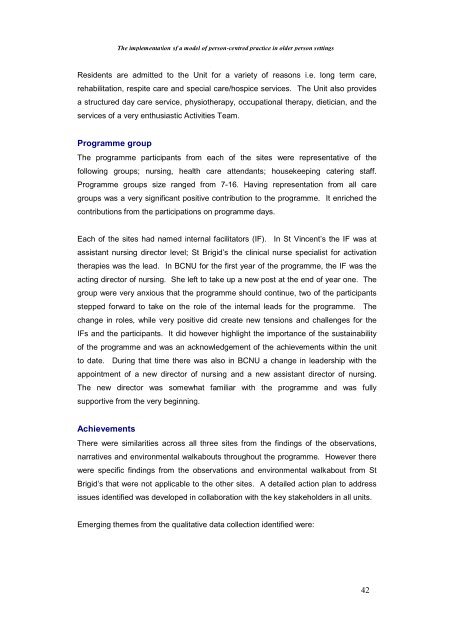The Implementation of a Model of Person-Centred Practice In Older ...
The Implementation of a Model of Person-Centred Practice In Older ...
The Implementation of a Model of Person-Centred Practice In Older ...
You also want an ePaper? Increase the reach of your titles
YUMPU automatically turns print PDFs into web optimized ePapers that Google loves.
<strong>The</strong> implementation <strong>of</strong> a model <strong>of</strong> person-centred practice in older person settings<br />
Residents are admitted to the Unit for a variety <strong>of</strong> reasons i.e. long term care,<br />
rehabilitation, respite care and special care/hospice services. <strong>The</strong> Unit also provides<br />
a structured day care service, physiotherapy, occupational therapy, dietician, and the<br />
services <strong>of</strong> a very enthusiastic Activities Team.<br />
Programme group<br />
<strong>The</strong> programme participants from each <strong>of</strong> the sites were representative <strong>of</strong> the<br />
following groups; nursing, health care attendants; housekeeping catering staff.<br />
Programme groups size ranged from 7-16. Having representation from all care<br />
groups was a very significant positive contribution to the programme. It enriched the<br />
contributions from the participations on programme days.<br />
Each <strong>of</strong> the sites had named internal facilitators (IF). <strong>In</strong> St Vincent’s the IF was at<br />
assistant nursing director level; St Brigid’s the clinical nurse specialist for activation<br />
therapies was the lead. <strong>In</strong> BCNU for the first year <strong>of</strong> the programme, the IF was the<br />
acting director <strong>of</strong> nursing. She left to take up a new post at the end <strong>of</strong> year one. <strong>The</strong><br />
group were very anxious that the programme should continue, two <strong>of</strong> the participants<br />
stepped forward to take on the role <strong>of</strong> the internal leads for the programme. <strong>The</strong><br />
change in roles, while very positive did create new tensions and challenges for the<br />
IFs and the participants. It did however highlight the importance <strong>of</strong> the sustainability<br />
<strong>of</strong> the programme and was an acknowledgement <strong>of</strong> the achievements within the unit<br />
to date. During that time there was also in BCNU a change in leadership with the<br />
appointment <strong>of</strong> a new director <strong>of</strong> nursing and a new assistant director <strong>of</strong> nursing.<br />
<strong>The</strong> new director was somewhat familiar with the programme and was fully<br />
supportive from the very beginning.<br />
Achievements<br />
<strong>The</strong>re were similarities across all three sites from the findings <strong>of</strong> the observations,<br />
narratives and environmental walkabouts throughout the programme. However there<br />
were specific findings from the observations and environmental walkabout from St<br />
Brigid’s that were not applicable to the other sites. A detailed action plan to address<br />
issues identified was developed in collaboration with the key stakeholders in all units.<br />
Emerging themes from the qualitative data collection identified were:<br />
42
















